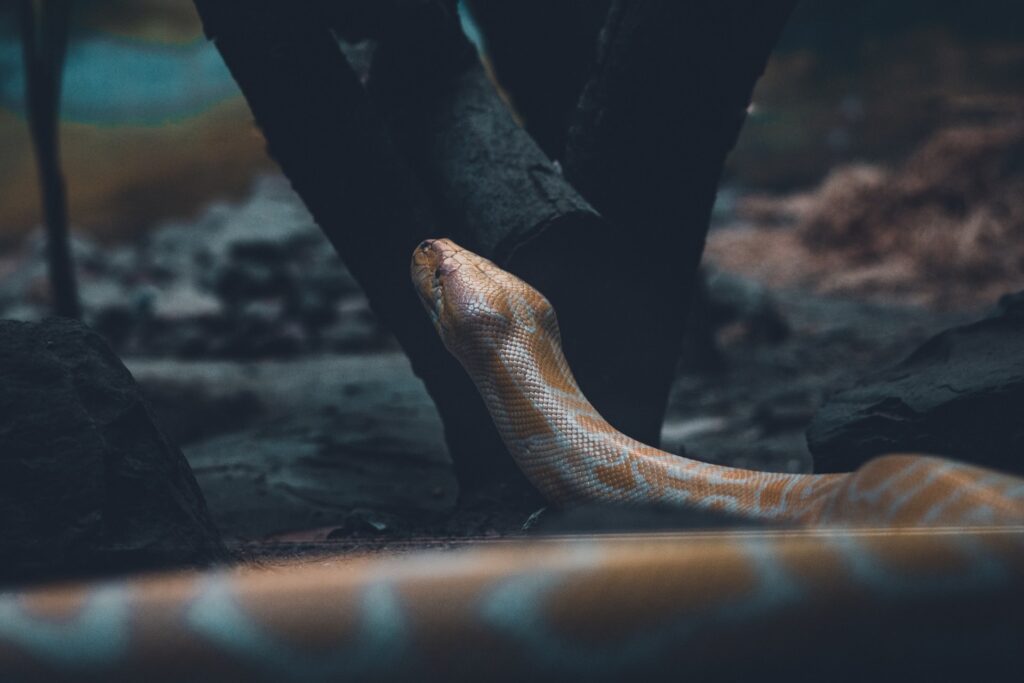Rishi Sahasrapat Regains his Human Form

Table of Contents (The Complete Mahabharata in Simple English)
Previous Post: Ruru’s Anger Toward Snakes
| Note: In the previous post, we read about Ruru’s decision to slay every snake and how he was pacified when he met the rishi (Sahasrapat) who had been transformed into a non-poisonous snake due to the curse of a brahmana. In this post, we will find out why Sahasrapat was transformed into a snake and how he could regain his human form. |
When asked by Ruru about who he was and how long he would have to remain a snake, the Dundubha (Rishi Sahasrapat) said, “A long time ago, I had a friend called Khagama. He had a lot of spiritual power which he had acquired through great austerities. However, he was very rash in his speech.”
One day, when Khagama was performing the Agni-Hotra Yagna, Sahasrapat made a toy snake with grass blades and tried to scare Khagama for fun. Khagama was indeed scared. He almost fainted. But when he recovered and found out that his friend had tried to mock him, he became filled with anger and said the following words to Sahasrapat, “Because you made a powerless mock snake to frighten me, you yourself will be turned into a non-poisonous serpent by my curse.”
Sahasrapat was aware that Khagama’s speech carried immense power because of his ascetic penances. He folded his hands and bowed down to his friend and said, “Dear friend, I did this as a joke to make you laugh. It is, therefore, not correct for you to curse me. Please take back your curse.”
When Khagama saw his friend in this state, he was moved by compassion, and, even though he was still very angry, he said, “O noble one, you will be freed from the curse on the day you see Ruru, the son of Pramati.”
Sahasrapat (who was still in the form of a Dundubha snake) addressing Sage Ruru said, “You are the same Ruru. I will tell you something for your good once I recover my human form.”
Saying this, Sahasrapat, transformed back into his original, bright human form, and said to Ruru, “O great one, mercy is the highest virtue of a man. Therefore, a brahmana should never kill another creature. He should always be mild. This is the most sacred teaching of the Vedas. A brahmana should be well-versed in the Vedas and Vedangas and should encourage all creatures to believe in God. Just like a brahmana should remember all the Vedas, he should also be kind to all creatures. It is the dharma of kshatriyas to be stern, to rule their subjects properly, and to use the sword. Your dharma is that of a brahmana and not a kshatriya.”
Rishi Sahasrapat told Ruru, that in the past, a king called Janamejaya had performed a sacrifice to destroy serpents. However, a brahmana called Astika saved the serpents. Astika had great knowledge of the Vedas and immense spiritual power.
Ruru was curious to know why king Janamejaya wanted to destroy the serpents. He asked the rishi, but Sahasrapat simply said that Ruru would hear Astika’s story from other brahmanas.
Saying this, Sahasrapat vanished.
Ruru ran about in the forest to search for the rishi but couldn’t find him anywhere. Ruru sat down with exhaustion, but the words of the rishi kept going on in his mind. These constant thoughts made his mind confused and foggy. After resting for some time, Ruru regained clarity of mind and returned home where he asked his father, Pramati, to tell him the story of Janamejaya’s snake sacrifice and the brahmana (Astika) who had saved the snakes.
| Note: With this post, we end the Puloma (sub) Parva of the Adi Parva. We will begin the Astika (sub) Parva in the next post, in which we will read about Janamejaya’s snake sacrifice and how Astika saved the snakes. |
Next Post: Sage Jaratkaru Meets his Pitris
Table of Contents (The Complete Mahabharata in Simple English)

